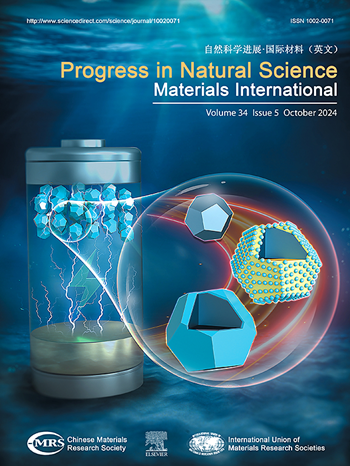Strong, tough, conductive cellulose/PAA gel enabled by in-situ esterification and noncovalent crosslinking for adaptive sensor
IF 7.1
2区 材料科学
Q2 MATERIALS SCIENCE, MULTIDISCIPLINARY
Progress in Natural Science: Materials International
Pub Date : 2025-08-01
DOI:10.1016/j.pnsc.2025.05.006
引用次数: 0
Abstract
Cellulose-based gels with flexibility, structural tunability and biocompatibility are applied in advanced fields. However, most of cellulose-based gels are still limited in insufficient mechanical strength and tedious preparation process. We have developed a tough and flexible cellulose/polyacrylic acid (cellulose/PAA) gel through a simple process involving in-situ esterification and photopolymerization within a polymerizable deep eutectic solvent (PDES: ZnCl2/acrylic acid/H2O). In this process, cellulose undergoes highly efficient dissolution (>7 wt% within 30 min) while simultaneously capturing acrylic acid (AA) in PDES by in situ esterification, endowing cellulose/PAA gel with a double-network structure through synergistic ester covalent crosslinking and dense hydrogen bond interaction. The hydrogen donor-acceptor capability of PDES, coupled with ester bond formation, induce a delocalization effect in AA, enabling spontaneous radical generation for photopolymerization without requiring external initiator and crosslinker. The resulting cellulose/PAA gel exhibit exceptional tensile strength (12.6 MPa) and toughness (4.24 MJ/m3), which is about 17.67 times than that of the pure cellulose gel. Furthermore, the synergistic presence of carboxyl groups and Zn2+ ions within cellulose/PAA gel impart high electric conductivity (4.7 mS/cm), enabling real-time detection of diverse physiological motions. The simple and effective method we present provides a pathway for the preparation of high-performance conductive gel from renewable biopolymer for flexible sensors applications.
强,坚韧,导电的纤维素/PAA凝胶通过原位酯化和非共价交联实现自适应传感器
纤维素基凝胶具有柔韧性、结构可调节性和生物相容性等优点,被广泛应用于先进领域。然而,大多数纤维素基凝胶仍然存在机械强度不足和制备过程繁琐的局限性。我们通过在可聚合的深度共晶溶剂(PDES: ZnCl2/丙烯酸/H2O)中进行原位酯化和光聚合的简单工艺,开发了一种坚韧柔韧的纤维素/聚丙烯酸(纤维素/PAA)凝胶。在此过程中,纤维素在30分钟内高效溶解(> 7wt %),同时通过原位酯化反应捕获PDES中的丙烯酸(AA),通过协同酯共价交联和密集的氢键相互作用,使纤维素/PAA凝胶具有双网络结构。PDES的供氢受体能力,加上酯键的形成,在AA中诱导离域效应,无需外部引发剂和交联剂就能自发产生光聚合自由基。制备的纤维素/PAA凝胶具有优异的抗拉强度(12.6 MPa)和韧性(4.24 MJ/m3),是纯纤维素凝胶的17.67倍。此外,纤维素/PAA凝胶中羧基和Zn2+离子的协同存在赋予了高导电性(4.7 mS/cm),能够实时检测各种生理运动。该方法简单有效,为柔性传感器用可再生生物聚合物制备高性能导电凝胶提供了一条途径。
本文章由计算机程序翻译,如有差异,请以英文原文为准。
求助全文
约1分钟内获得全文
求助全文
来源期刊
CiteScore
8.60
自引率
2.10%
发文量
2812
审稿时长
49 days
期刊介绍:
Progress in Natural Science: Materials International provides scientists and engineers throughout the world with a central vehicle for the exchange and dissemination of basic theoretical studies and applied research of advanced materials. The emphasis is placed on original research, both analytical and experimental, which is of permanent interest to engineers and scientists, covering all aspects of new materials and technologies, such as, energy and environmental materials; advanced structural materials; advanced transportation materials, functional and electronic materials; nano-scale and amorphous materials; health and biological materials; materials modeling and simulation; materials characterization; and so on. The latest research achievements and innovative papers in basic theoretical studies and applied research of material science will be carefully selected and promptly reported. Thus, the aim of this Journal is to serve the global materials science and technology community with the latest research findings.
As a service to readers, an international bibliography of recent publications in advanced materials is published bimonthly.

 求助内容:
求助内容: 应助结果提醒方式:
应助结果提醒方式:


